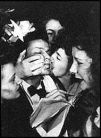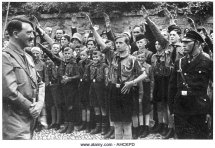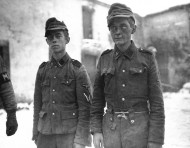My point, once again, is not that those ancient people told literal stories and we are now smart enough to take them symbolically, but that they told them symbolically and we are now dumb enough to take them literally. ― John Dominic Crossan
Where were you (or your parents) on October 12th, 1944? If you were a teenage girl in the New York City area, you might have been in or, more likely, outside the Paramount Theater,  where some thirty to thirty-five thousand adolescent girls made such a commotion that authorities dubbed the event the “Columbus Day Riot.” These girls were in “a squealing ecstasy,” according to Time
where some thirty to thirty-five thousand adolescent girls made such a commotion that authorities dubbed the event the “Columbus Day Riot.” These girls were in “a squealing ecstasy,” according to Time  magazine – freaking out, as ta later generation would say – over the presence of the pop idol Frank Sinatra.
magazine – freaking out, as ta later generation would say – over the presence of the pop idol Frank Sinatra.
Ten years later, their daughters would act the same way over Elvis Presley, as I record in Chapter Eleven of my book Madness at the Gates of the City: The Myth of American Innocence. Here is the account by one of Elvis’ band members:
I heard feet like a thundering herd, and the next thing I knew I heard this voice from the shower area…
by the time we got there several hundred must have crawled in… Elvis was on top of one of the showers…his shirt was shredded and his coat was torn to pieces. Somebody had even gotten the belt and his socks…he was up there with nothing but his pants on and they were trying to pull at them up on the shower.
Ten years further on, their younger sisters reacted to the Beatles with similarly riotous behavior:
The same collective urge that gave rise to the Twist also propelled John Kennedy into office and invited idealism and new possibilities. Consequently, youth took his death particularly hard. It is no coincidence that a new form of maenadism – “Beatlemania” – erupted only two months later. Ehrenreich writes, “At no time during their U.S. tours was the group audible above the shrieking.” Susan Douglas argues that the resonance between Kennedy and the Beatles allowed for “a powerful and collective transfer of hope.”
But we’re getting ahead of ourselves and must also address the second myth. If you lived in Germany in 1944  and you were a teenage boy, you may well have been a member of the 12th SS-Panzer Division Hitlerjugend, the army of boy soldiers. You might have been one of the 600 survivors of a military unit that had numbered some 10,000 boys only months before. They had confronted the Allied invasion, often fighting to the last boy, and their brethren would continue to fanatically resist, dying in the thousands in the final battle for Berlin (while other thousands of slightly older Japanese men were committing suicide as kamikaze pilots in the Pacific).
and you were a teenage boy, you may well have been a member of the 12th SS-Panzer Division Hitlerjugend, the army of boy soldiers. You might have been one of the 600 survivors of a military unit that had numbered some 10,000 boys only months before. They had confronted the Allied invasion, often fighting to the last boy, and their brethren would continue to fanatically resist, dying in the thousands in the final battle for Berlin (while other thousands of slightly older Japanese men were committing suicide as kamikaze pilots in the Pacific).
Myths are the stories we tell ourselves about ourselves. More purely than in any other example I can cite, these two groups of teenagers were enacting the two great mythic narratives that came to fruition in the twentieth century, myths that western culture had literalized since long before the Greeks and Hebrews created stories to name them.
The American girls were either modern day maenads (from the same Greek root that gives us mania and manic), or they were bacchants. The bacchants willingly worshipped the god Dionysus in irrational, ecstatic trance. The maenads, by contrast, were the mythic women who went insane because they had refused to recognize him as divine. Chapter Two of my book delves into the differences between them, and the cultural significance of their choices. Chapter Twelve speculates about how this eruption of energy led directly to the politics of the 1960s and the feminist movement.
But the German boys, sadly, were enacting the myth of the Killing of the Children, which I address in Chapter Six. Most of them were sixteen or younger, having entered school in the early 1930s. They had been deluged with Nazi propaganda since early childhood and had been groomed by their elders to offer up their bodies in the great ritual sacrifice of modern, nationalistic war, to kill for the fatherland, or, perhaps more importantly, to die for it.
perhaps more importantly, to die for it.
Stripping away the superficial religious imagery, we can see that they were in no way different from the Iranian children who would proudly step on land mines in the Iran-Iraq war forty years later.
Many of my readers may be aware that I often recite two poems during our poetry salons and rituals. These poems speak to these two myths. The conflict between them has been at the center of western culture for two thousand years.
The first myth speaks of the explosive surge of erotic and creative energies – the meeting of the spiritual and the sexual – that each new generation offers to its community and the world. It is the cyclic renewal of the world, if the older generations are willing to honor it. The Invocation to Dionysus introduces us to it:
Be good to us, you girl-crazy goat!
We the poets begin and end our singing through you,
And it’s impossible without you.
Without remembering you, we cannot remember our sacred songs!
The second myth speaks of how western man lost both his knowledge of the old initiation rituals and his protective concern for his own children, how, instead of symbolically killing boys so that they might transition into authentic adults, he gradually made the choice to sacrifice them quite literally. The killing of the children is the great, unspoken (and therefore sacred) secret behind the myth of American innocence.
This myth was best given poetic expression by the other poem I often recite, by the World War One poet Wilfred Owen:
Parable of the Old Man and the Young
So Abram rose, and clave the wood, and went,
And took the fire with him, and a knife.
And as they sojourned both of them together,
Isaac the first-born spake and said, My Father,
Behold the preparations, fire and iron,
But where the lamb for this burnt-offering?
Then Abram bound the youth with belts and straps,
and builded parapets and trenches there,
And stretchèd forth the knife to slay his son.
When lo! an angel called him out of heaven,
Saying, Lay not thy hand upon the lad,
Neither do anything to him. Behold,
A ram, caught in a thicket by its horns;
Offer the Ram of Pride instead of him.
But the old man would not so, but slew his son,
And half the seed of Europe, one by one.
And, to make things truly mythic, that is, truly complicated, consider that there is a point where these two narratives intersect, in Euripides’ Bacchae. After Dionysus drives the female disbelievers mad, they attack the king and slaughter him, led by his own mother.One way we can interpret this scene is that the release of repressed energy under patriarchy results in the slaughter of the innocent.
How do we see this enacted in the real world? Certainly, the political movements that emerged out of the 1960s, as well as their contemporary versions, express this eruptive, archetypal and necessary energy. But without a meaningful mythology and strong ritual containers, there can be no certainty that anything positive will result. The emergence of Donald Trump is such an example.
We’ve lived in a “demythologized world” for centuries. When myths that once bound us together in worlds of meaning die, the soul – and the soul of the culture – find substitutes. Ritual conflict degenerates into literal violence. The fundamentalist religions and nationalist politics that convince the young to sacrifice themselves for some abstract idealare, along with addiction, our worst examples. The two came together in the great communal ideologies of the past century, most notably the Fascism that sent those Hitlerjugenders to their deaths.
But the demythologized world is also the genesis of the other myth. At one level, those crazed teenage girls in 1944 (and 1954 and 1964) became maenads for a few hours. No harm was done, and perhaps quite a lot of good resulted. But on another level, they were giving away – projecting – much of their innate nobility (noble is related to gnosis. A noble is someone who knows who she is) to public figures who could temporarily embody such characteristics. This is what we mean by the “culture of celebrity.” As I write in Chapter One,
Instead of developing relationships with Aphrodite or Zeus, we adore each in a succession of actresses or politicians, who inevitably betray us by proving to be all too human.
As the quote that begins this essay indicates, there is no reason to assume that ancient and indigenous people could not think mythologically. This means to constantly search for the archetypal significance in human events, to perceive meaning on several levels simultaneously, aware that the literal, psychological and symbolic dimensions of reality complement and interpenetrate each other to make a greater whole.
Actually, it is we who have, by and large, lost this capacity. This is why we worship celebrities. But it is also why we die in the tens of thousands of opioid abuse, and why we condemn millions to the furnaces of modern warfare and climate change. And this is why we have to regain this capacity.